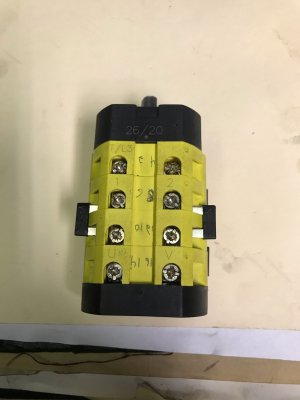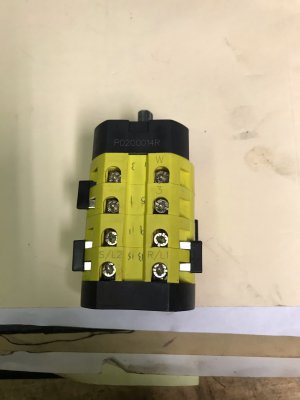-
Welcome back Guest! Did you know you can mentor other members here at H-M? If not, please check out our Relaunch of Hobby Machinist Mentoring Program!
You are using an out of date browser. It may not display this or other websites correctly.
You should upgrade or use an alternative browser.
You should upgrade or use an alternative browser.
3 Phase Delta WYE Resistances
- Thread starter Scra99tch
- Start date
- Joined
- Dec 2, 2016
- Messages
- 234
One thing is I would like to be able to proof out the new switch to change its Order of operations so that it is a 0-1-2 instead of the factory 1-0-2 jst to limit stress on motor I guess.
I think this is doable but I jsut have to mimic the old switch layout and this is where I get lost real fast.
I think this is doable but I jsut have to mimic the old switch layout and this is where I get lost real fast.
- Joined
- Dec 2, 2016
- Messages
- 234
This is where I am struggling as I am not seeing the position of the old switch because of the cam action internally.
I know these things
UaVaWa whould be contacting RST somehow and UbVbWb would be disconnected. I can see this happening. But high speed is a little more difficult because of the connection of all the A terminals.
I know these things
UaVaWa whould be contacting RST somehow and UbVbWb would be disconnected. I can see this happening. But high speed is a little more difficult because of the connection of all the A terminals.
- Joined
- Dec 2, 2016
- Messages
- 234
The new switch schematic looks like it is correct as 1,2,3 all tie together and UVW(b) all connect to line (RST) when position two is selected.
So now down the line wounder if the contactor is causing the problem.
So now down the line wounder if the contactor is causing the problem.
- Joined
- Dec 23, 2019
- Messages
- 1,138
Not sure I can be of much help, other than to suggest you make diagrams of the switch and motor you can use to draw out what needs to go where in each configuration. The available diagrams are not always user friendly. You may also find the the switch is not set up internally to achieve what you're looking to do; there may be a reason it's in that config from factory.
I ditched the switches on my machines when I changed away from the Dahlander connection scheme altogether and run VFD. This was more to do with setting the motors up for low voltage, but I'm very happy not to have to ever deal with multi pole switch wiring as an added bonus.
I ditched the switches on my machines when I changed away from the Dahlander connection scheme altogether and run VFD. This was more to do with setting the motors up for low voltage, but I'm very happy not to have to ever deal with multi pole switch wiring as an added bonus.
- Joined
- Dec 2, 2016
- Messages
- 234
Thanks
Logically the switch looks correct. I went back through it and it supposed to do what it needs to to switch from low speed (only 1,2,3 connected to line) and high speed (connected to UVW w/ 1,2,3 shorted).
I am about to jump to a VFD but the motor itself has a mechanical braking feature which I would like to keep original if possible.
Logically the switch looks correct. I went back through it and it supposed to do what it needs to to switch from low speed (only 1,2,3 connected to line) and high speed (connected to UVW w/ 1,2,3 shorted).
I am about to jump to a VFD but the motor itself has a mechanical braking feature which I would like to keep original if possible.
- Joined
- Dec 23, 2019
- Messages
- 1,138
If you're running VFD you can only really use the switch as a speed selector, providing switching is done with the motor at a stop. They do not like the load being switched. VFD dynamic braking is very effective - and many come with an option of external resistors for this purpose - so no need for a mechanical brake in that respect anyway. If there's a requirement for a static brake I'm sure it's possible to figure something out to utilise the mechanism separately.
- Joined
- Dec 2, 2016
- Messages
- 234
I finally came to grasp with my limited ability that I should start from ground zero and use my multi meter to troubleshoot everything in that electrical path.
Once I could proof out logically the switch and make sure that the terminals were correct. I then said okay low speed it just UAVAWA connected to line. Which ends up being correct on the sheet supplied (so I bought the right switch after all). High Speed is then UAVAWA all jumped and line into UBVBWB again shown electrically on the switch diagram.
Once I got the switch hooked up motor would still not work. What would happen was the thermal breaker would trip, thinking I still had something shorted. I check the breaker and sure enough it had gone bad. Mind you these Siemens mechanical breakers are something to look at neat little machines in themselves. I noticed a tiny, must of been a 25 gauges wire was melted on the coil side of the breaker. It was something I could not get to without disassembling, and that would of destroyed the breaker as it was riveted together. I figured I would upgrade to something modern at this point, received it last Wednesday and put it in this weekend. Fired her up and was able to cycle through the two speeds.
I am thinking I will slowly upgrade all the breakers.
What I learned is before applying power to things you don't know much about think it through and run your non-destructive tests. I played around enough with it to have that sinking feeling that I cooked the motor windings. No shop would touch this motor as it 1/4 HP but its casing is machine to fit nicely plus it has a mechanical brake built in to slow the workhead down quickly, this includes a slow timed limit switch to cut power to the motor.
Once I could proof out logically the switch and make sure that the terminals were correct. I then said okay low speed it just UAVAWA connected to line. Which ends up being correct on the sheet supplied (so I bought the right switch after all). High Speed is then UAVAWA all jumped and line into UBVBWB again shown electrically on the switch diagram.
Once I got the switch hooked up motor would still not work. What would happen was the thermal breaker would trip, thinking I still had something shorted. I check the breaker and sure enough it had gone bad. Mind you these Siemens mechanical breakers are something to look at neat little machines in themselves. I noticed a tiny, must of been a 25 gauges wire was melted on the coil side of the breaker. It was something I could not get to without disassembling, and that would of destroyed the breaker as it was riveted together. I figured I would upgrade to something modern at this point, received it last Wednesday and put it in this weekend. Fired her up and was able to cycle through the two speeds.
I am thinking I will slowly upgrade all the breakers.
What I learned is before applying power to things you don't know much about think it through and run your non-destructive tests. I played around enough with it to have that sinking feeling that I cooked the motor windings. No shop would touch this motor as it 1/4 HP but its casing is machine to fit nicely plus it has a mechanical brake built in to slow the workhead down quickly, this includes a slow timed limit switch to cut power to the motor.



